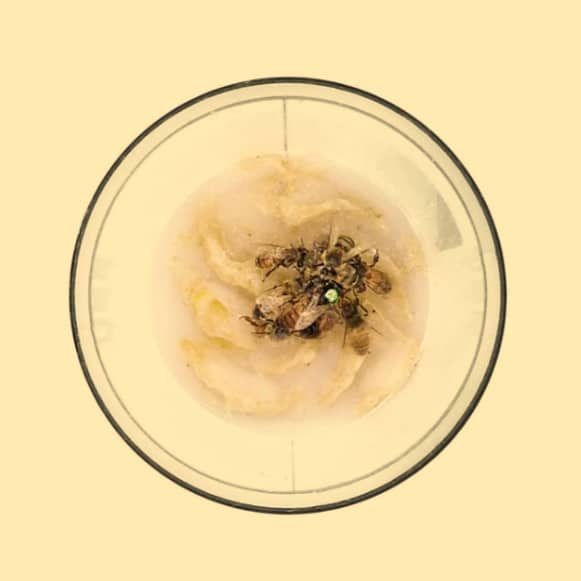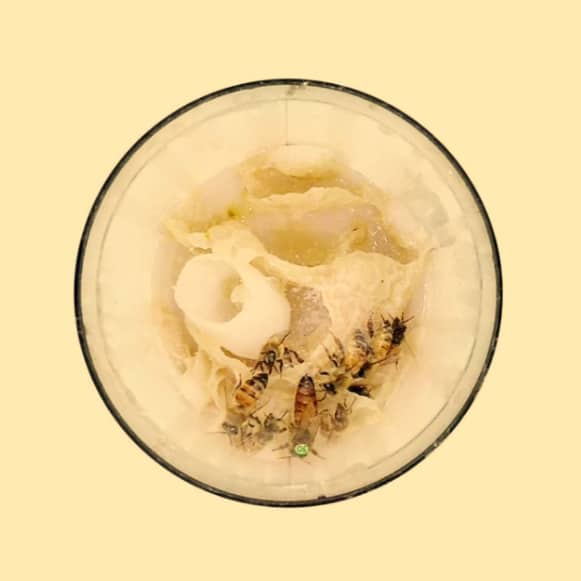As professional beekeepers, a question we get asked often is “How are the bees doing?” We lose nearly one-half of all beehives almost every year. While the varroa mite poses a danger to the overall health of bees, other factors include climate change, a reduction of native flora and plants, and habitat loss.
There are more than 3,600 species of native bees in North America, but today we honor the Apis Mellifera, our powerful and vital pollinator friends in celebration of National Honeybee Day. In order to recognize the honeybee, we wanted to tell you just how the bees are doing and how we hope to improve the bee population and the overall health of bees.
Building a Better Bee with Science
Science will save the bees. Every time one of our beekeepers service a client’s beehive, they not only provide high-quality care, but also detailed reports. The data and reports are shared with our research partners to advance the science of beekeeping to improve the health of pollinators worldwide.
Continue reading below to learn more about our continued success in our approach to mite treatments to better address local conditions and how we initiated our own queen rearing programs.
Finding an Organic Treatment for the Varroa Mite
One of our top priorities in 2010, when we started as a company, was to find a way to combat varroa mites while practicing organic beekeeping The varroa mite, a parasitic pest, is one of the primary causes of colony loss. It was important to find an organic solution that was effective, to face this massive problem.
Through partners in the beekeeping community, we learned that FORMIC PRO, a low-toxicity synthetic treatment, was getting good results in mite control. Our controlled study found that what others saw was true: Formic Pro successfully reduced mite infestation in 83% of our hives.
In our attempts to find an even safer and more effective treatment, we’ve found that the feed enhancer Hive Alive, an organic solution made of essential oils and seaweed, helps improve colony strength. Indications from other beekeepers suggest it may be effective, but we’ll be conducting more extensive tests to learn if it can be used as a substitution for our current synthetic treatments.
Queen Rearing for Local Conditions
Spring is when we begin our queen rearing initiatives. Queen rearing is the process of producing new queens by manipulating various colony attributes. With the intention of developing colonies that can better survive cold winters and fight off varroa mites with little treatment, their larvae are selected from hives based on mite resistance and survival rates.
As noted by our chief scientific officer, Noah Wilson-Rich, “If we use our hive data to select the best queen genetic material possible, we can develop hives that are uniquely adapted to the needs of different geographies.”
Bees in Space
Why send bees into space? In 2019, we partnered with MIT Media Lab to send bees into space on Blue Origin’s New Shepard, the same rocket that Jeff Bezos used to recently travel into outer space.


According to the MIT Media Lab, the project explored what behavioral or physiological differences may arise in the queen bee, in light of the extreme forces and unique environmental gradients traversed en voyage; including thermal gradients of 0 to 60°C, gravitational-forces of 0 to 15 G, and vertical velocities up to 1 km/s.
During the flight, the systems intended to maintain the queens’ metabolic processes were designed to be dynamically shared by retinue bees and human-made monitors: joint regulatory activity, respectively powered on sugar and electricity.
When the bees safely returned to Earth, we were able to have a better understanding of how honeybee fertility and behavior respond to extreme environments, as well as give us a glimpse into the future of farming.
The Best Bees Beekeeping Data
Bees are critical for a strong food system, economic security, and environmental resiliency. Our approach to solving the decline of pollinator health is threefold:
- Bzzz, our proprietary hive management system that records beehive data and prepares it for research and analysis.
- Standardized beekeeping practices uniquely developed to control variables in our dataset to ensure data is reliable for ongoing research.
- Track data points from over 50,000 hive visits to measure population, queen health, and mite levels in thousands of beehives nationwide.
The data collected from our network of beehives is able to help us understand the current state and the future of the honeybee.
What the Data Tells us about the Queen’s Reign
Over the past year, we’ve begun to study the reign of our queens and have found that few actually make it to three years.
One downside to letting queens “reign” too long is that their brood production can become weak and irregular, or even stop altogether. If that happens later in the season, a replacement queen may not be able to make up for the lost bees and honey production that comes with a full-sized colony.
Shay Willette, Head Beekeeper at Best Bees notes, “Brood patterns are one way we gauge whether or not a queen needs to be replaced. There are factors that we use as indicators such as behavior towards the queen, her physical health, supersedure cells, and disease in broods.”

Colony Crowding
We encourage people to keep bees, especially in urban communities that large commercial beekeepers have traditionally avoided, to help build up the nation’s supply of bees, and to supplement the native pollinators in those areas.
Some of the voices in the pollinator community voiced concern that a situation called “colony crowding” might occur, where the carrying capacity of the area is exceeded, leading to hive robbing, diminished honey stocks, weakened hives, and a decline in native pollinators.
Out of the studies examining pollinator competition, the evidence is inconclusive. Results showed 53% reporting negative effects on wild bees, 28% reporting no effects, and 19% reported mixed effects (varying with the bee species or variables examined).
In 2020, our own research did not observe significant differences between densely, moderately or sparsely honeybee-populated areas. This tells us that at the current density, our honeybees are not correlated to colony crowding.
If you are interested in doing your own research and spreading awareness about bees and pollination for National Honey Bee Day, check out the website iNaturalist, a joint initiative of the California Academy of Sciences and the National Geographic Society to help and foster everyday observation that can contribute to biodiversity science.
Biodiversity Mapping
HoneyDNA can give ecologists and planners a much more precise look at the local floral environment than possible through human observation. HoneyDNA can tell them about the presence of rare and endangered species, and it can alert them to the introduction of invasive species. We can learn which plants are thriving and which are declining, and whether we’re losing essential genetic diversity.
We’ve been gathering data for 6 years and accumulated 502 unique plant species in our HoneyDNA samples from honeybees across the US. In 2020, this year we discovered 30 new species, bringing our library to 532. Some of the new species included:
- Pineapple
- Coastal Sweet Pepper Bush
- Southern Blue Gum
- Red Bayberry
HoneyDNA can even help with disaster response. Studying HoneyDNA before and after hurricanes in Puerto Rico, we learned which plant species were most devastated by storms, and which had the fastest recovery. This information can be used by local planning authorities to influence them to plant flora that can mitigate environmental damage and to accelerate regeneration.
In 2020, we took samples from regions impacted by the California wildfires. After the fire, we see a significant increase in foraging from a wide range of stone fruits, among other shifts. The results showed the following:
El Sobrante, CA hive: 1 Before fire (2019)
- 38.13% — buckthorn
- 35.67% — black greasewood
- 17.70% — Wild buckwheat
- 8.51% — Stone fruits
El Sobrante, CA hive 1: After fire (2020)
- 68.37% — stone fruits
- 21.3% —Willows
- 2.36% —rosemary
- 1.73% — medicks
Throughout the end of 2022, we’ll continue to analyze the data and work with local authorities to share our findings and help planners make informed decisions about sustainable development.
Innovative Projects Saving the Bees
In order to acknowledge the role of bees and other pollinators for the ecosystem, we must recognize the beekeepers, projects, and research that are collectively attempting to to understand trends, analyze what’s working and what isn’t, and create a barometer of environmental stability in the beekeeping industry.
Best Bees Current and Upcoming Projects
Our beekeepers are constantly bursting with ideas for new research projects to answer the myriad questions that come up during their work and personal research. Each study inevitably leads to more questions. Here’s what our team is hoping to accomplish in the next few years.
Understanding Brood Gaps
Brood gaps can exist for two reasons—queens can be distressed because of mite treatments, or some bees (Carniolan) do it naturally in response to the seasonal availability of pollen and nectar. While it is fairly common and not a concern, we’re looking forward to studying more to understand why it happens. Is it due to genetic traits based on resource management? Or Hygienic behavior? How can we tell the difference?
Location Based Behavior
It’s possible that the location of a beehive can impact the behavior of a colony. Not just where in the world the bees are, but specific details such as how does wind, shade, or the direction the hive is facing affect the calmness of a colony? With our network of hives throughout the US, we can collect data and make decisions on where to put future hives based on our findings.
Colony Collapse Disorder
The imminent threat may be less common, but we’re still aware of the impacts of CCD. We found five hives that died this year with similar symptoms to CCD. Is it coming back? Should we be concerned?
Next Generation Beekeepers
As a collective community of beekeepers, we can solve the crisis together with shared knowledge, data, and research. Below are a few beekeepers and programs that are innovative and at the forefront of the celebrating bees in unique ways.
The Intimacy Project
The Intimacy Machine is an allopoietic machine that aims to build a refuge for encountering bees on a more egalitarian basis by challenging the forthcoming of smart hives into the world of beekeeping. Recently, digital apparatuses and algorithms have infiltrated our beehives to monitor, track and record bee behaviour in order to help beekeepers develop less invasive and time-consuming practices.
Here are some up close still images of a bee rolling a ball (of pollen) to help you celebrate how bees are doing in 2021. For more projects hosted by the Intimacy Project, you can view their archives here.
Urban Bee Laboratory
Best Bees affiliated non-profit, The Urban Beekeeping Lab, is a 503(c) non-profit on a mission to save the bees. It sees bees as the ultimate tie that binds food security, climate change, natural disaster mitigation, and ecological preservation. The UBL believes that in order to save the world, we must save the bees.
The Urban Bee Laboratory’s new website will be released soon. The UBL site is designed to help us discover how honey holds the secret to healing our planet. Some of the UBL projects to keep an eye out for are Mapping Honey DNA, Pollinator Blue Zones, the Synthetic Apiary, and Maiden Flight (Bees in Space).

According to the Washington Post, it is suggested “that if enough home gardeners plant targeted plants, the bees’ habitat loss will be mitigated, and the bees will show up. “These are very small animals; you don’t need 100 acres to make an impact. A tiny bee can do well in a small residential setting,” Sarver said. “It’s a great opportunity for conserving biodiversity, but enough of us have to do it.”
For National Honeybee Day, we hope we can all bring awareness for the honey bee, honey bee enthusiasts, beekeeping associations and clubs, and beekeepers. To learn even more about how honey bees are doing, download our latest whitepaper, The State of the Honeybee.






